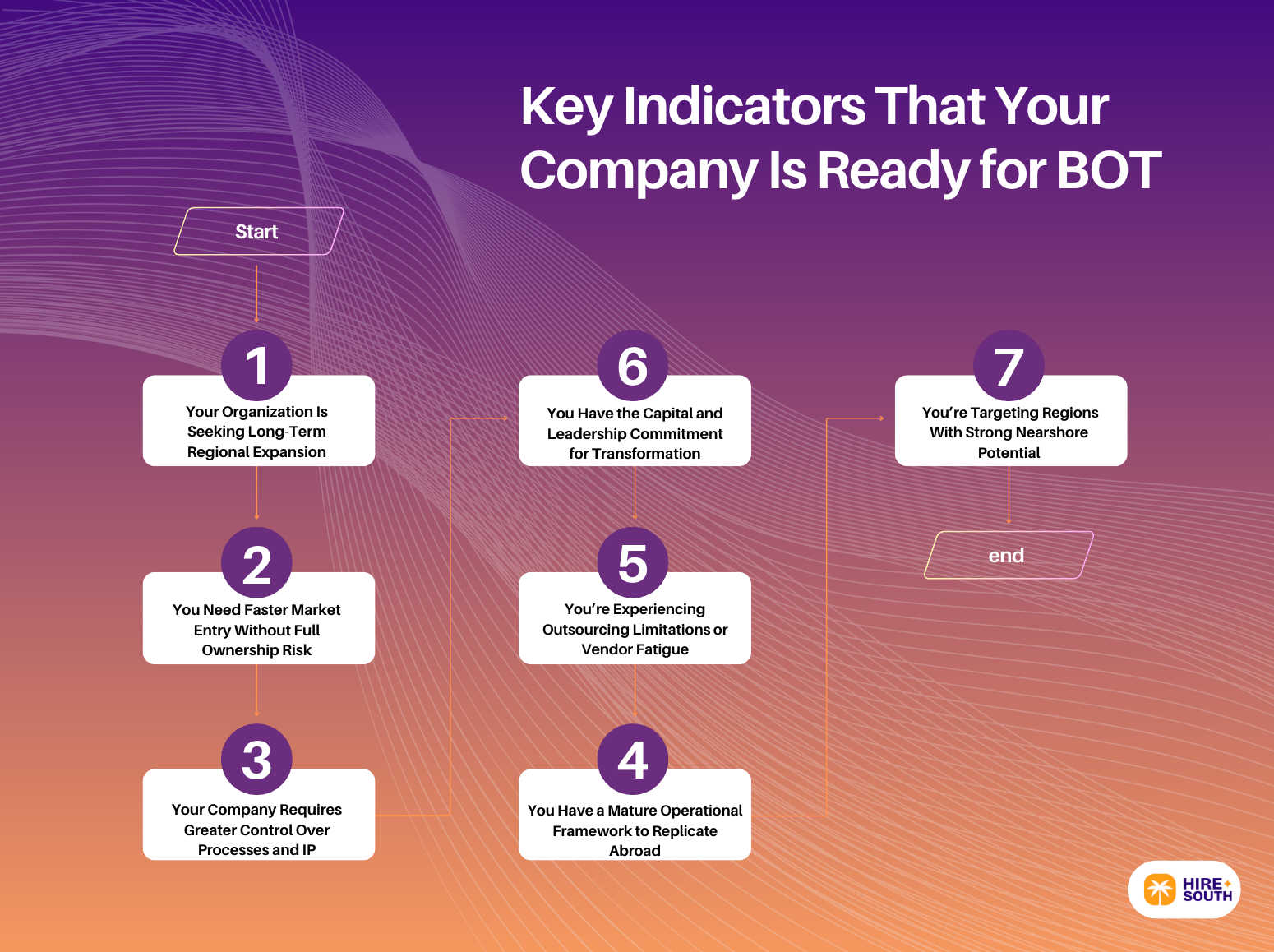Expanding into new markets is no longer just about setting up shop; it’s about building operations that can scale, adapt, and deliver ROI fast. That’s where the Build-Operate-Transfer (BOT) model comes in. It’s a proven framework that lets global companies establish teams in emerging regions like Latin America, operate efficiently under expert local management, and eventually take full ownership.
In the past three years, investment in Latin American tech hubs has grown over 60%, according to the Inter-American Development Bank, positioning the region as a strategic hotspot for companies seeking sustainable, cost-efficient expansion. From Brazil to Colombia, businesses are using the BOT Latin America model to tap into skilled talent, streamline operations, and scale globally, without losing control.
This article breaks down everything you need to know before making the move. You’ll learn how the BOT model works, why Latin America is becoming a preferred destination, how to evaluate your BOT model ROI, and the key Build Operate Transfer benefits for long-term growth. By the end, you’ll have a clear view of whether BOT Latin America is the right fit for your business goals. Keep reading to get started!
Why Latin America Is Emerging as a BOT Powerhouse
1. Strategic Nearshore Location and Time Zone Alignment:
Latin America’s location offers a unique advantage for companies in North America and Europe pursuing the Build-Operate-Transfer model. The region’s proximity allows teams to work in overlapping time zones, minimizing delays in communication and project delivery. For example, cities like São Paulo, Bogotá, and Mexico City share only a one- to three-hour difference with major US hubs like New York or San Francisco.
This nearshore alignment reduces operational friction, allowing for real-time collaboration and faster decision-making, two critical elements in the BOT model’s operate phase. Compared to Asia-based outsourcing models, nearshoring to Latin America can improve productivity by up to 25%, according to Everest Group’s 2023 global services report.
2. A Rapidly Expanding Tech Talent Pool:
Latin America’s workforce is one of the most skilled and fast-growing in the world. The World Bank reports that the region graduates over 500,000 STEM professionals annually, with strong concentrations in software engineering, AI, and data analytics. Cities like Buenos Aires, Guadalajara, and Santiago have become major tech education hubs, supported by government-funded innovation programs.
For companies implementing a BOT Latin America strategy, this means access to a large pool of technical professionals capable of scaling operations quickly. The growing availability of English-speaking developers also bridges cultural and communication gaps, reducing onboarding time and increasing integration efficiency during the build and operate stages.
3. Competitive Operating Costs With High ROI Potential:
A key driver behind Latin America’s rise as a BOT powerhouse is cost efficiency without compromising quality. Operating costs in countries like Colombia and Peru can be 30–50% lower than in the United States, according to Statista’s 2024 Global Wage Comparison Index. This includes not just salaries, but also real estate, taxes, and benefits.
Lower costs translate directly into stronger BOT model ROI, especially for companies looking to test new markets or scale development teams. The savings allow organizations to reinvest in innovation and training, leading to sustainable value creation once the transfer phase is complete.
4. Strong Government Support and Pro-Business Policies:
Governments across Latin America have embraced the BOT framework as part of their digital and economic transformation agendas. Countries like Mexico, Chile, and Costa Rica offer tax incentives, simplified regulatory processes, and public-private partnerships to attract foreign investment in technology and infrastructure.
According to the OECD, Latin America has seen a 40% increase in foreign direct investment in technology-driven projects over the past five years. This stability and policy support make the region a low-risk option for companies that need to build and operate under secure, transparent frameworks before taking ownership in the transfer stage.
5. Increasing Digital Infrastructure and Innovation Capacity:
Latin America’s digital infrastructure has evolved dramatically in the past decade. With major investments from global firms like Amazon Web Services, Google Cloud, and Microsoft Azure, the region’s cloud capacity and data connectivity have expanded by over 60% since 2019, according to IDC Latin America.
This digital maturity makes it easier for businesses to set up BOT operations with minimal latency and high data security standards. Advanced connectivity enables seamless remote collaboration, while emerging innovation ecosystems, like Brazil’s Campinas Tech Park and Chile’s Startup Chile, foster ongoing R&D opportunities within BOT frameworks.
6. Cultural Compatibility and Workforce Resilience:
Cultural alignment plays a major role in the success of any Build-Operate-Transfer model, and Latin America excels in this area. Professionals in the region share similar work ethics, communication styles, and corporate values with North American and European teams, leading to smoother collaboration and faster integration.
Moreover, the Latin American workforce is known for adaptability and resilience. A 2023 Deloitte survey found that 78% of Latin American professionals rank flexibility and innovation as top workplace values, critical traits in the iterative phases of the BOT model. This makes the region a natural fit for companies that rely on agile operations and cross-functional teamwork.
7. Proven Success Stories Across Key Sectors:
From fintech to manufacturing, global enterprises are already proving the success of BOT Latin America. For instance, IBM and Accenture have both implemented nearshore BOT operations in Mexico and Argentina, reporting faster project turnaround times and stronger team retention compared to offshore models.
The model has also gained traction in the energy and telecom sectors, where local expertise and infrastructure compliance are vital. These real-world examples demonstrate how the Build-Operate-Transfer model in Latin America delivers not only cost savings but also measurable performance improvements across industries.
The Business Case for BOT Latin America
1. Leveraging the BOT Model for Sustainable Business Scaling:
When companies consider expanding operations, scalability is often the main challenge. The Build-Operate-Transfer model in Latin America offers a clear path to scale without the high upfront costs of building a local entity from scratch. It enables you to establish a fully functional operation, test the market under a local management team, and gradually transition ownership once performance metrics are met.
According to KPMG’s 2024 Global Shared Services Report, organizations using nearshore BOT setups can achieve up to 35% faster scalability compared to traditional outsourcing. This structure reduces dependency on third-party vendors while allowing internal teams to retain control and build local expertise, two factors critical to long-term growth in new markets.
2. Lower Risk Through Localized Expertise and Governance:
A key advantage of the BOT Latin America model is its ability to minimize operational and compliance risk. Local BOT partners understand regional employment laws, tax regulations, and labor frameworks, helping you avoid costly mistakes in the operate phase.
For example, countries like Chile and Mexico maintain strict data protection laws that align closely with GDPR standards, ensuring regulatory stability for international companies. Research from PwC Latin America shows that 68% of companies using a BOT structure in the region reported fewer compliance-related disruptions than those using direct outsourcing models.
This local insight is especially valuable in industries such as finance, healthcare, and technology, where governance and security standards are non-negotiable.
3. Access to a Skilled and Cost-Efficient Workforce:
The business case for BOT Latin America is heavily supported by its balance of affordability and technical skill. Labor costs are competitive, and software engineers in Colombia or Peru typically earn 40–60% less than their US counterparts, according to Statista’s 2024 salary benchmarks, while maintaining strong technical and communication capabilities.
In addition, universities across Latin America have deepened partnerships with the private sector to align education with real-world business needs. This steady supply of bilingual, tech-savvy professionals creates an ideal environment for BOT operations to thrive, especially in industries like SaaS development, AI integration, and customer support.
4. Accelerating ROI Through Controlled Market Entry:
Unlike full acquisitions or greenfield investments, the BOT model lets you validate a market before committing large capital. The “operate” stage provides an evidence-based approach to gauge profitability, cultural fit, and operational efficiency. Once results meet your expectations, the transfer phase allows for smooth integration into your organization with minimal disruption.
A study by the Inter-American Development Bank (IDB) found that foreign companies entering Latin America via BOT or hybrid nearshore models achieved 20–25% higher ROI within the first two years compared to those pursuing direct investments. This measured approach helps avoid premature spending and creates data-backed confidence before scaling up.
5. Enhanced Control and Intellectual Property Ownership:
Control and IP protection remain top concerns for businesses expanding abroad. The BOT framework addresses these by ensuring that intellectual property, internal processes, and technology remain fully owned by the parent company after transfer.
This is a key differentiator from traditional outsourcing, where IP ownership can often be ambiguous. Under a BOT structure, your company retains control over proprietary software, operational data, and client relationships, strengthening long-term strategic independence. In Latin America, where IP enforcement has improved under trade agreements like USMCA and Mercosur, this model adds a significant layer of legal and operational security.
6. Strong Return on Talent Retention and Organizational Culture:
Employee retention is another strong argument for adopting BOT Latin America as a scaling model. Because the operation is built with your brand and culture in mind, teams integrate more deeply than in outsourced environments.
This consistency reduces hiring churn, enhances project continuity, and preserves institutional knowledge across the build, operate, and transfer stages. The result is a team that not only understands your business but also grows with it.
7. Long-Term Strategic Value Beyond Cost Savings:
While cost optimization is often the initial motivation, the business case for BOT in Latin America extends far beyond budgets. The model lays the groundwork for innovation, R&D development, and regional market expansion. Once transferred, your organization owns a fully operational hub that can support new business units, serve local clients, or function as a regional headquarters.
In the long run, this strategic footprint strengthens resilience and positions your company to compete effectively in fast-growing emerging markets. The combination of control, scalability, and measurable ROI makes BOT Latin America not just a cost-saving tactic, but a forward-looking growth strategy.
Evaluating the ROI of the BOT Model
Understanding What Drives BOT Model ROI:
The ROI of the Build-Operate-Transfer (BOT) model depends on how efficiently each phase, build, operate, and transfer, is executed. Unlike outsourcing, where cost savings are immediate but control is limited, the BOT framework delivers measurable ROI over time by transferring ownership and operational knowledge back to you.
Key ROI drivers include reduced setup costs, improved operational performance, and faster time-to-market. A big performance lift comes from tighter alignment between the parent company’s goals and local execution teams.
Measuring ROI Through Cost Efficiency and Value Creation:
Evaluating the financial ROI of a BOT model goes beyond direct cost savings. It’s about the long-term value created through asset ownership, talent retention, and local market integration. During the “operate” phase, fixed costs typically decline as local teams optimize workflows and leverage economies of scale.
Benchmark data from Statista’s 2024 Global Business Services Index shows that companies using BOT structures in Latin America save between 30% and 45% on total operational costs compared to equivalent in-house operations in North America. Over time, those savings compound once ownership transitions, since recurring vendor fees are eliminated.
To fully measure ROI, you should also factor in qualitative outcomes such as faster innovation cycles, improved knowledge retention, and increased customer satisfaction, all of which directly support long-term profitability.
Comparing BOT Model ROI to Traditional Outsourcing:
When compared to outsourcing, the BOT model ROI typically outperforms after the third operational year. Outsourcing may offer short-term savings but limits flexibility and control over processes, while BOT allows you to internalize assets, teams, and know-how.
A KPMG study on global delivery models (2023) found that businesses using BOT or hybrid nearshore models in Latin America achieved 20–30% higher ROI than those relying solely on outsourcing partnerships. The primary reason: once transferred, the operation becomes a self-sustaining business unit with no external profit margins attached.
This model also protects intellectual property and reduces dependency risks, two areas where traditional outsourcing often underperforms from an ROI perspective.
Time-to-Value and Payback Period:
For most organizations, the BOT model’s payback period typically ranges between 18 to 36 months, depending on the project scale and country of operation. This relatively short timeframe is made possible by Latin America’s competitive labor market, government incentives, and nearshore collaboration advantages.
The build phase represents the bulk of initial costs, covering infrastructure setup, recruitment, and onboarding, but those investments pay off as the operate phase begins to generate efficiencies. Once the transfer phase is complete, operating expenses drop significantly, often improving profit margins by double digits within the first year of ownership.
Performance Metrics That Define BOT Success:
A structured approach to ROI measurement includes tracking metrics across financial, operational, and human capital dimensions. These typically include:
- Operational cost savings compared to baseline projections
- Employee retention and productivity growth within the BOT center
- Time-to-market for new products or services
- Reduction in vendor dependency or contract costs
- Quality assurance and compliance adherence rates
By integrating these KPIs into quarterly performance reviews, you can calculate the true ROI of BOT operations, not just in dollars saved, but in strategic value gained. According to Gartner’s 2024 Nearshore Delivery Benchmark, companies that tracked at least five of these metrics achieved an average ROI uplift of 22% over three years.
The Compounding Value of Ownership After Transfer:
The most underestimated component of the BOT model ROI is post-transfer value. Once ownership transitions, the cost structure stabilizes, and the local operation often becomes an innovation hub or regional service center. This shift turns a cost-saving initiative into a long-term strategic asset.
By owning the infrastructure, teams, and operational IP, your company gains independence from third-party vendors and reduces future expansion costs. Data from EY’s 2024 Global Operations Review found that firms that retained and transferred BOT centers achieved 40% higher five-year ROI than those that continued outsourcing.
Ownership also opens the door to new revenue streams, such as serving external clients or expanding into nearby markets, multiplying returns beyond the initial investment.
The 7 Key Indicators That Your Company Is Ready for BOT

1. Your Organization Is Seeking Long-Term Regional Expansion:
If your business strategy includes establishing a sustained presence in a specific market rather than short-term outsourcing, it’s a strong indicator that you’re ready for a Build-Operate-Transfer (BOT) model. BOT structures allow you to build a foundation in a new region, operate under expert local management, and eventually assume full control once performance and stability are proven.
If your organization plans to grow headcount, localize operations, or serve new customers directly, BOT provides the structure to do it efficiently and sustainably.
2. You Need Faster Market Entry Without Full Ownership Risk:
When time-to-market is a top priority but the cost and regulatory risks of immediate ownership are high, BOT offers an ideal middle ground. You can enter a market quickly by leveraging an experienced local partner who handles the initial build and operations. Once the operation stabilizes, ownership transfers to your company seamlessly. If speed and agility are critical to your strategy, BOT readiness is likely on your horizon.
3. Your Company Requires Greater Control Over Processes and IP:
Businesses that have outgrown traditional outsourcing or face concerns about intellectual property control often find BOT a natural progression. The model allows you to retain full ownership of assets, data, and proprietary systems after transfer, without losing operational control in the early stages. If your business depends heavily on proprietary technology, software, or data analytics, this model provides both flexibility and security while maintaining compliance with regional laws.
4. You Have a Mature Operational Framework to Replicate Abroad:
The BOT model works best when your internal processes, governance systems, and performance metrics are already standardized. If your organization has defined KPIs, strong project management frameworks, and clear reporting mechanisms, replicating that structure abroad becomes far more efficient.
According to Gartner’s Nearshore Delivery Report 2024, companies with mature internal systems experienced 50% fewer operational delays when setting up BOT centers compared to those with ad hoc processes. If your business can clearly define “what success looks like” in measurable terms, it’s well-positioned to launch a BOT initiative in Latin America or other nearshore markets.
5. You’re Experiencing Outsourcing Limitations or Vendor Fatigue:
If outsourcing partnerships have reached a point where cost savings plateau and innovation slows, your company may be ready for a BOT transition. The model provides continuity and knowledge transfer while giving you the ability to internalize operations once they’re optimized.
A Deloitte outsourcing trends survey found that 61% of organizations planned to shift from traditional outsourcing toward hybrid or BOT models to gain more control, improve transparency, and ensure talent retention. When third-party vendors start to limit your ability to scale or innovate, it’s a strong indicator that BOT is the next logical step.
6. You Have the Capital and Leadership Commitment for Transformation:
While BOT offers long-term savings, it requires initial investment in infrastructure, training, and management alignment. Companies ready for BOT typically have executive-level buy-in and a financial plan that supports a 12–24 month setup and optimization period. If your leadership team is committed to sustainable expansion and not just short-term gains, your organization likely has the readiness profile for BOT success.
7. You’re Targeting Regions With Strong Nearshore Potential:
Not every geography delivers equal value through BOT. If your expansion goals align with regions like Latin America, where skilled talent, favorable time zones, and cost efficiencies converge, you’re in the right environment for a successful implementation. When your target region offers the infrastructure and talent maturity to support scalable operations, your company is ready to move forward with the BOT approach.
Ready to Get Started in BOT Latin America?
Choosing to launch a Build-Operate-Transfer model in Latin America is more than a cost decision; it’s a long-term strategy to strengthen operational control, enhance scalability, and access world-class talent in nearshore markets. With Latin America’s tech workforce growing 65% over the past five years, the region has proven itself as a mature ecosystem for BOT-driven innovation and business expansion.
At Hire South, we specialize in helping global companies with our staff augmentation and outsourcing solutions across Latin America. Our team ensures every possible talent is committed and tailored to your business goals. For organizations ready to scale sustainably and maximize ROI through outsourcing, we provide the expertise and on-the-ground support to make it happen efficiently and transparently. Schedule a free discovery call today!

Ready to Hire LATAM Talent?
Let us do the legwork to find your perfect remote hire in Latin America!







.svg)